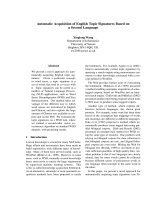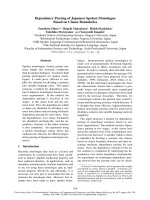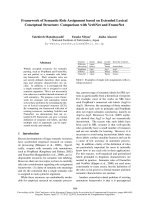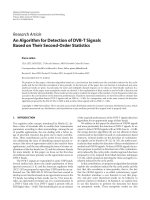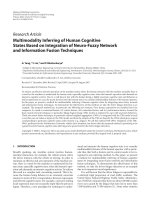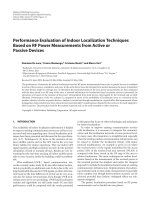Development of DNA Extraction Kit Based on Silica-Coated Magnetic Nanoparticles for Formalin-Fixed a
Bạn đang xem bản rút gọn của tài liệu. Xem và tải ngay bản đầy đủ của tài liệu tại đây (635.74 KB, 9 trang )
<span class='text_page_counter'>(1)</span><div class='page_container' data-page=1>
277
277
Development of DNA Extraction Kit Based on Silica-Coated
Magnetic Nanoparticles for Formalin-Fixed and
Paraffin-Embedded Cancer Tissues
Nguyen Thi Huyen
1<sub>, Le Duc Linh</sub>
1<sub>, Pham Thi Thu Huong</sub>
1<sub>, </sub>
Nguyen Minh Hieu
2<sub>, Nguyen Hoang Nam</sub>
2<sub>, Tran Thi My</sub>
1,3<sub>, </sub>
Nguyen Hoa Anh
3<sub>, Phan Tuan Nghia</sub>
1<sub>, Nguyen Thi Van Anh</sub>
1,*<sub> </sub>
1<i><sub>Key Laboratory of Enzyme and Protein Technology, </sub></i>
<i>VNU University of Science, 334 Nguyen Trai, Thanh Xuan, Hanoi, Vietnam </i>
2<i><sub>Center for Nano and Energy, VNU University of Science, 334 Nguyen Trai, Thanh Xuan, Hanoi, Vietnam </sub></i>
3<i><sub>ANABIO Research & Development Company, 22 Lien Khe, Van Khe Urban, Ha Dong, Hanoi, Vietnam </sub></i>
<i> </i>
Received 06 August 2016
Revised 26 August 2016; Accepted 09 September 2016
<b>Abstract: The aim of this study is to develop a kit for the extraction of DNA from formalin fixed </b>
paraffin embedded (FFPE) tissues using silica-coated magnetic nanoparticles Fe3O4@SiO2 (MagSi
nano) and suitable buffers. We selected the best version of synthesized MagSi nano (code M1) and
optimised buffers including Lysis Buffer (code LB2) and Binding Buffer (code BB2) for
extracting DNA from FFPE tissues with highest DNA recovery (84 - 103 ng/l) and good purity
(A260/A280 around 1.8 - 2.0). Using the MagPure FFPE DNA nano kit based on the selected MagSi
nano and the optimised LB2 + BB2 buffers, we successfully performed extraction of DNA from
FFPE tissues of colon and nasopharyngeal carcinoma patients. The extracted DNAs from FFPE
<i>colon cancer tissues could be used as templates for downstream amplifying and sequencing Braf </i>
bio marker gene, and the extracted DNAs from nasopharyngeal cancer tissues could be used as
templates for downstream detection of Epstein-Barr virus (EBV) using real-time Taqman PCR. In
sum, the MagPure FFPE DNA nano kit is potential for extraction of DNA from FFPE tissues, and
need to be further developed to improve DNA recovery yield for application in diagnostics of
cancers using molecular biology.
<i>Keywords: Silica-coated magnetic nanoparticles Fe3O4@SiO2, DNA extraction, FFPE cancer </i>
tissue, PCR, DNA sequencing.
<b>1. Introduction *</b>
The archives of formalin-fixed and
paraffin-embedded (FFPE) tissues are extensive sources
for histopathological diagnosis of diseases,
_______
*<sub> Corresponding author. Tel.: 84-4-35579515 </sub>
Email:
</div>
<span class='text_page_counter'>(2)</span><div class='page_container' data-page=2>
using the method of silica-membrane-based
nucleic acid extraction which is created by
Boom and colleagues [4-6]. Mechanism of this
extraction method is high affinity of the
negative charged DNA backbone towards the
positive charged silica particles under a
condition of high concentration of chemotropic
salts [7 - 9]. For robotic DNA extraction from
FFPE tissues, companies such as Promega, and
Thermo Scientific, have produced kits based on
silica-coated magnetic micro beads. However,
to the best of our knowledge, DNA extraction
kits from FFPE tissues based on silica-coated
nano particles are not yet commercialized or
under development. Recently, our group have
synthesized silica-coated magnetic
nanoparticles Fe3O4@SiO2 (magnetic
nanoparticles Fe3O4 coated with SiO2, named as
MagSi nano) and optimised buffers to develop
MagPure nano kits to extract DNA from
bacteria, virus, blood cells and agarose gel [10 -
12]. In comparison to the micrometer-size
silica-coated magnetic beads and silica
membrane tubes, silica-coated magnetic
nanoparticles have larger total surface area and
superparamagnetic properties, thus they could
be more functional in purification of DNA from
samples [13]. Extracted DNA by MagPure kits
was qualified as templates for downstream
reactions such as PCR, Real time PCR, and
DNA sequencing. In this study, we further
developed a kit for DNA extraction from FFPE
tissues based on silica-coated magnetic
nanoparticles. The extracted DNA samples
using the kit were tested their quality and
quantity for downstream applications such as
<i>PCR combined DNA sequencing of Braf gene </i>
as biomarker for colon cancer tissues, and Real
time PCR for detection of EBV virus from
tissues of nasopharyngeal carcinoma patients.
<b>2. Material and method </b>
<i>2.1. Materials </i>
FFPE tissues samples of colon cancer were
provided by Center for Gene and Protein
Research, Hanoi Medical University. FFPE
tissues of nasopharyngeal carcinoma patients
were provided by Department of
Pathophysiology, Vietnam Military Medical
<i>Institute. </i>
MagSi nano (Fe3O4@SiO2, magnetic
nanoparticles Fe3O4 coated with SiO2) with
properties as listed in Table 1 was provided by
a research group at Center of Nano and
Energy, VNU University of Science. All
other reagents were standardized for
<i>experiments in molecular biology. </i>
Table 1. Properties of MagSi nano (Fe3O4@SiO2)
No Properties Values
M1 M2 M3
1 Concentration of MagSi nano 50 mg/ml 50 mg/ml 50 mg/ml
2 Saturation magnetisation of core Fe3O4
particles 64 emu/g 64 emu/g 64 emu/g
3 Average diameter of core Fe3O4
nanoparticles 10-20 nm 10-20 nm 10-20 nm
4 Saturation magnetisation of MagSi nano 49 emu/g 44 emu/g 35 emu/g
</div>
<span class='text_page_counter'>(3)</span><div class='page_container' data-page=3>
<i>2.2. Methods </i>
<i>2.2.1. Preparation of DNA extraction buffers </i>
A set of nucleic acid extraction buffer was
prepared as follows: (i) proteinase K 20 mg / ml
(BioBasic), (ii) Lysis Buffer (LB) contained
Tris-HCl and SDS at different concentrations
(iii) Binding Buffer (BB) contained chaotropic
salts (GuHCl, Triton X-100) and EDTA at
different concentrations, (iii) Washing buffer 1
(WB1) and (iv) Washing Buffer 2 (WB2)
contained Tris-HCl plus high concentration of
ethanol for washing other organic compounds
from DNA-MagSi nano complexes, and (v)
Elution Buffer contained of Tris-HCl at basic pH
<i>to isolate nucleic acids from MagSi nano. </i>
<i>2.2.2. Preparation of FFPE samples </i>
For each DNA extraction, 10 mg of FFPE
tissue was cut into 8-10 thin sections of 5-10
m thick, then added into an eppendorf tube
with 500 µl mineral oil. The tube was vortexed
and incubated at 60o<sub>C for 5 min to release </sub>
paraffin into the mineral oil. Then, the oil was
removed and the tissue was washed with
ethanol 96o<sub> twice, followed by dd H</sub>
2O once.
Finally, the tissue was dried at 37o<i><sub>C for 5 min. </sub></i>
<i>2.2.3. Extraction of DNA from FFPE tissues </i>
200 µl LB and 40 µl Proteinase K 20 mg/ml
were added into an eppendorf tube then the tube
was mixed thoroughly by vortexing for 10 s and
incubated at initial 60o<sub>C for 60 min, then </sub>
further 90o<sub>C for 60 min. After incubation, 400 </sub>
µl BB, 200 µl of absolute isopropanol, and 100
µl of MagSi nano were added into the cell
lysate. The suspension was mixed thoroughly,
then allowed to stand at room temperature (RT)
for 3 min for binding of DNA on MagSi nano.
The DNA-MagSi nano complexes were
collected by applying an external magnet for
10-15 s and the clear supernatant was discarded.
The complexes were washed with 1 ml of WB1
and then 1 ml WB2, to remove proteins, salts
and other impurities. The residual ethanol in
WB2 was completely removed and evaporated
by air drying at RT. Finally, 50 µl of EB was
added to the complexes, and the tube was
placed on a magnet in order to collect the
supernatant containing genomic DNA (gDNA).
<i>2.2.4. Measurement of concentration and </i>
<i>purity of purified DNA </i>
Spectrophotometer Nanodrop (ND100, Life
Technology) was used to measure absorbance
of purified DNA at wavelengths of 260 nm and
280 nm. A260 was used to calculate DNA
concentrations, and ratios of A260/A280 was used
to estimate contamination levels of proteins and
<i>RNA. </i>
<i>2.2.5. PCR-based amplification and DNA </i>
<i>sequencing of Braf gene using the extracted </i>
<i>DNA as templates </i>
The extracted DNA using optimised MagSi
nano and buffers (MagPure FFPE DNA nano
kit) were used as templates for PCR to amplify
<i>a specific sequence of Braf gene. A primer set </i>
<i>for specific amplification of exon 15 of Braf </i>
gene, which generates a DNA product of 252
bps (named as Braf), contained Fw Braf
5’-TCATAATGCTTGCTCTGATAG- 3’ and Rv
Braf 5’- CTTTCTAGTAACTCAGCAGC-3’. 5
µl of total 50 µl purified DNA from 10 mg
FFPE tissues was used for each PCR reaction
with a total volume of 25 µl. PCR was
performed using thermal conditions as follow:
preheating at 94o<sub>C for 3 min, 35 cycles at 94</sub>o<sub>C </sub>
for 30 min, 58o<sub>C for 30 s, 72</sub>o<sub>C for 30 min with </sub>
a final extension at 72o<sub>C for 5 min. Amplified </sub>
PCR products were run on 1,5% agarose gel
followed by staining with fluorescent ethidium
bromide for visualisation of DNA band under
UV excitation. DNA sequencing of each PCR
product was performed under service of IDT
Company using either Fw Braf or Rv Braf
primers and the obtained sequences were
<i>analysed using ApE software. </i>
<i>2.2.6. Real time PCR to detect EBV using </i>
<i>the extracted DNA as templates </i>
</div>
<span class='text_page_counter'>(4)</span><div class='page_container' data-page=4>
BNRF1 p143 of EBV. Primers included
EBV-74 forward
5′-GGAACCTGGTCATCCTTGC-3, EBV-74 reverse 5
′-ACGTGCATGGACCGGTTAAT-3’, and the
probe FAM
5′-CGCAGGCACTCG.TACTGCTCGCT-3′
TAMRA. 5 µl of total 50 µl purified DNA from
10 mg FFPE tissues was used for each real time
PCR reaction with a total volume of 25 µl. The
real-time PCR conditions included 42 cycles of
15 s at 95°C and 60 s at 60°C [7].
<b>3. Results and Discussion </b>
<i>3.1. Optimisation of Lysis and Binding Buffers </i>
The first step of our research is to optimise
the two buffers including Lysis Buffer (LB) and
Binding Buffer (BB) which play the most
important roles in extracting DNA from FFPE
tissues. We made 3 different recipes for each
pair of buffers coded LB1+BB1, LB2+BB2,
LB3+BB3 and tested these buffers on clinical
samples of patient 1 and patient 2 following the
DNA extraction methods as described in the
Materials and Methods. In all samples, the same
MagSi nano code M1 and 10 mg amounts of
FFPE samples were used. Experiments for each
buffer pair were repeated 3 times. As result, the
electrophoresis data showed that extracted
gDNA was fragmented into less than 1kb-size
smear bands, in which and LB2+BB2 provided
the brightest ones (Fig. 1A). The extracted
DNAs were used as templates for PCR
<i>amplifying specific 252 bp sequences of Braf </i>
genes. As shown in Fig.1B, the LB2+BB2
provided the best recovery and quality of DNA
templates as indicated by the brightest and the
most evenly intensities of PCR bands.
j
</div>
<span class='text_page_counter'>(5)</span><div class='page_container' data-page=5>
A. 1% agarose-gel electrophoresis of DNA
extracted from FFPE tissues of patient 1 (A1)
and patient 2 (A2) using different lysis and
binding buffers (LB1+BB1, LB2+BB2,
BL3+BB3). B. 1.5% agarose-gel
electrophoresis for PCR products amplifying
<i>Braf genes of patient 1 (B1) and patient 2 (B2) </i>
using extracted DNAs by MagPure kit using 3
different pairs of buffers (LB1+BB1,
LB2+BB2, LB3+BB3).
DNA extracted from 2 patient samples was
evaluated concentration and purities using
optical density method. The extracted DNA
using LB2+BB2 buffers had highest absorbance
values in samples of both patients (102.8 ± 6.94
ng/µl for the patient 1 and 84.1 ± 4.99 ng/µl for
<i>patient 2, n = 3) (Fig. 2). This data was </i>
consistent to the data obtained in Fig. 1, in
which LB2+BB2 buffers provided the best
results. All DNA samples extracted using 3
pairs of buffers had values of A260/A280 ranging
between 1.9 - 2.2 (Table 2), indicating they all
had good purity. Taken together, we selected
LB2+BB2 buffers for further steps in
<b>development of the kit. </b>
Table 2. Yield and purity of DNA extracted from FFPE tissues
of colon cancer patients using different pairs of Lysis and Binding buffers
Buffer
Concentration of DNA (ng/l) A<sub>260</sub>/A<sub>280</sub>
patient 1 <b>patient 2 </b> patient 1 <b>patient 2 </b>
LB1+BB1 53.6 ± 5.75 60.0 ± 18.22 2.00 ± 0.02 2.03 ± 0.05
<b>LB2+BB2 </b> <b>102.8 ± 6.94 </b> <b>84.1 ± 4.99 </b> <b>1.95 ± 0.02 </b> <b>1.97 ± 0.03 </b>
LB3+BB3 44.2 ± 10.38 58.2 ± 9.99 2.21 ± 0.18 2.04 ± 0.07
<i><b>j </b></i>
<i>3.2. Selection of the most suitable MagSi nano </i>
Using a similar approach, we tested three
types of Magsi nano particles coded M1, M2,
M3 (with different saturation magnetisation of
silica-coated Fe3O4@SiO2 particles and
thickness of silica layer as described in Table 1)
together with the optimised LB2+BB2 buffers
to extract DNA from FFPE tissues. We could
not perform experiments on the same FFPE
tissue of patient 1 and 2 as the amount of tissue
sample was limited. Thus, we performed on
FFPE tissue of patient 3 and experiments for
each MagSi nano version were repeated 3
times. The results of DNA electrophoresis on
1% agarose gel showed that gDNA extracted by
the three MagSi nano structures were all highly
fragmented into smear bands, in which M1
provided the brightest bands (Fig. 2A).
<b>j </b>
<b> A </b> <b>B </b>
<b> </b>
</div>
<span class='text_page_counter'>(6)</span><div class='page_container' data-page=6>
A. 1% agarose-gel electrophoresis of
DNA extracted from FFPE tissues of patient 3
using different MagSi nano versions (M1, M2,
M3). B. 1,5% agarose-gel electrophoresis for
<i>PCR products amplifying Braf gene using </i>
extracted DNAs by MagPure kit using different
MagSi nano versions (M1, M2, M3).
The extracted DNA was used as template
for PCR amplifying specific 252 bp sequence of
<i>Braf gene (Fig. 2B). The M1 provided PCR </i>
bands having the brightest and the most evenly
intensity (Fig. 1B). We then measured
concentration and purity of DNA and found that
DNA extracted by M1 particle had the highest
concentration (34.47 ± 3.2 ng/µl), which was
5-fold higher than that by M2 (5.67 ± 0.8
ng/µl) and twice as much as that by M3 (16.6
± 1.5 ng/µl) (Table 3). The data of
absorbance values were consistent to the
electrophoresis data obtained in Fig. 3. The
purity of DNA was good with the A260/A280
between 1.8 and 2.2 (Table 3), indicating that
contamination of protein and ARN was low.
Taken this data and the above data, we
selected the MagSi nano M1 and LB2+BB2
buffers as major components of MagPure
FFPE DNA nano kit (Fig. 3).
Table 3. Yields and purities of DNAs
extracted from FFPE tissues of colon cancer
patients using different MagSi nano versions.
Mag Si nano
version
Concentration of
DNA (ng/l)
A<sub>260</sub>/A<sub>280</sub>
M1 34.47 ± 3.2 1.84 ± 0.03
M2 5.67 ± 0.8 1.83 ± 0.22
M3 16.6 ± 1.5 1.82 ± 0.06
Figure 3. MagPure FFPE DNA nano kit
(100 reactions). The kit contains LB2 (200 ml),
BB2 (50 ml), WB1 (50 ml concentrated),
WB2 (30 ml concentrated), EB (20 ml), Proteinase K
(2 ml 20mg/ml) and MagSi nano M1
(2.5 ml/tube x 2 tubes).
<i>3.3. Downstream application of extracted DNA </i>
<i>from FFPE tissues </i>
<i>DNA sequencing of Braf biomarker gene from </i>
<i>colon cancer tissues </i>
<i>The PCR products of Braf genes from the </i>
above experiments were used as templates for
DNA sequencing to check whether their sequence
are readable in order to detect any mutations. As
representative data obtained in Fig. 4A, we could
observe sharp and clear peaks of nucleotides
<i>sequence of Braf gene of patient 1. The sharp peaks </i>
without any noises indicates that extracted DNA is
completely free of cross-linkages, and qualified for
DNA sequencing analysis. The sequence of patient
1 was analysed to be 100% identical to a sequence
<i>(start: 176309; end: 176560) of Braf gene posted in </i>
NCBI databases (Sequence ID: ref|NG_007873.3|
<i>Homo </i> <i>sapiens </i> <i>Bfaf </i> proto-oncogene,
serine/threonine kinase) (Fig. 4B). Similar data of
<i>DNA sequencing was obtained with Braf genes </i>
from patient 2 and 3 (data not shown).
</div>
<span class='text_page_counter'>(7)</span><div class='page_container' data-page=7>
GA.
<b>B. </b>
<i>Figure 4. DNA sequencing of biomarker Braf gene of patient 1 </i>
using a DNA template purified by MagPure kit.
<i>Sequential peaks of nucleic acids of Braf gene of patient 1 (A) and homology analysis </i>
<i>of the Braf gene of patient 1 (Query 1) to the sequence NG_007873.3 </i>Homo sapiens
<i>Braf proto-oncogene</i> from NCBI database (Sbjct) (B).
<i>Figure 5. Amplification chart of FAM signals representing EBV during cycles of real-time PCR. </i>
<i>The curves of EBV-positive patients were no. 135, 366, 429, 928, 5648. </i>
</div>
<span class='text_page_counter'>(8)</span><div class='page_container' data-page=8>
<i>Real time PCR detection of EBV in throat </i>
<i>cancer tissues </i>
In another application, we used Magpure
FFPE DNA nano kit for extracting DNA from
six FFPE tissue samples of throat cancer, and
used the extracted DNA as templates for
real-time PCR to detect Epstein Barr Virus (EBV).
As shown in Figure 5, the FAM signals
representing were detected in all six samples
(no. 135, 366, 429, 928, 5648). Confirmation
was made by no signal of FAM in a negative
control and a clear FAM signal detected in a
positive control. Our data indicates that the
Magpure FFPE DNA nano kit could extract
DNA of the EBV present in the tissue samples,
and that the extracted DNA was qualified for
further real time PCR detection of specific
74-bp sequence of nonglycosylated membrane
protein named BNRF1 p143 of EBV.
<b>4. Conclusion </b>
In summary, we developed Magpure FFPE
DNA kit based on optimization of the MagSi
nano M1 and a pair of LB2 + BB2 buffers. The
yield of DNA was about 84-103 ng/l with low
contamination of proteins and RNAs as indicated
by the ratio of A260/A280 around 1.8 - 2.0. The
extracted DNAs were qualified for downstream
application such as PCR, DNA sequencing and
real time PCR. In addition, the extraction
procedure of MagPure FFPE DNA nano kit was
not required either centrifugation or vacuum
filtration. Thus, the kit is potential for application
in diagnostics of cancers and need to be further
<b>optimised to obtain a higher DNA concentration. </b>
<b>Acknowledgments </b>
This research is funded by the Vietnam
National University, Hanoi (VNU) under project
number QG.16.22 to N.T.V.A. The authors would
like to thank Assoc. Prof. Tran Van Khanh and
Assoc. Prof. Nguyen Linh Toan for providing us
with the FFPE tissue samples.
<b>References </b>
[1] Ahmad-Neiad P, Duda A, Sucker A, Werner M,
et al. (2015), “Assessing quality and
functionality of DNA isolated from FFPE tissues
through external quality assessment in tissue
banks”, Clinical Chemistry and Laboratory
<b>Medicine, 53(12), pp. 1972-34. </b>
[2] McSherry E. A., McGoldrick A., Kay E. W,
Hopkins A. M., Gallagher W. M., Dervan P. A.
(2007), “Formalin-Fixed Paran-Embedded
Clinical Tissues Show Spurious Copy Number
Changes in Array-CGH Proles”, Clin Genetics,
<b>72, pp. 441 - 447. </b>
[3] Shi S. R, Datar R., Liu C, Wu L, Zhang Z, Cote
R. J, Taylor C. R. (2004), “DNA extraction from
archival formalin-fixed, paraffin-embedded
tissues: heat induced retrieval in alkaline solution”,
<b>Histochem Cell Biol, 122, pp. 211 - 218. </b>
[4] Boom R., Sol C. J. A, Beld M, Weel J,
Goudsmit J, Dillen P. W. V. (1999), “Improved
Silica-Guanidiniumthiocyanate DNA Isolation
Procedure Base on Selective Binding of Bovine
Alpha-Casein to Silica Particles”, J Clinic
<b>Microbiol, 37, pp. 615-619. </b>
[5] Boom R., Sol C. J. A., R, Heijtink R. Wertheim-
van Dillen P. M. E, Van Der Noordaa J. (1991),
“Rapid purification of Hepatitis B virus DNA from
<b>serum”, J Clinic Microbiol, 29, pp. 1804 - 1811. </b>
[6] Boom R, Sol C. J. A, Salimans M. M. M, Jansen
C. L, Wertheim P. M. E. (1990), “Rapid and
simple method for purification of nucleic acids”,
<b>J Clinic Microbiol, 28, pp. 495 - 503. </b>
[7] Esser K. H, Marx W. H, Lisowsky T. (2006),
“MaxXbond: first regeneration system for DNA
binding silicamatrices”, Nature methods, 3,
<b>pp. 1 - 2. </b>
[8] Berensmeier S. (2006), “Magnetic particles for
the separation and purification of nucleic acid”,
Applied Microbiology and Biotechnology, 73,
<b>pp. 495 - 504. </b>
[9] Kathryn A. M, Chris S. S, Robin F. B. T,
Charles A. H. J., “Driving Force for DNA
Adsorption to Silica in Perchlorate Solutions”, J.
<b>Colloid and Interface Sci 181 (1996) 635. </b>
[10] Pham T. T, Dao V. Q, Nguyen M. H, Nguyen T.
</div>
<span class='text_page_counter'>(9)</span><div class='page_container' data-page=9>
magnetic nanoparticles for application in PCR
detection of the virus”. VNU Journal of Science:
<b>Natural Sciences and Technology, 28, pp. 195. </b>
[11] Nguyen T. H, Dao V. Q, Nguyen H. N, Nguyen
H. L, Tran T. V. K., Nguyen T. V. A. (2014),
“Efficient purification of DNA from blood cells
using silica- coated magnetic nanoparticles and
suitable buffers”, VNU Journal of Science:
Natural Sciences and Technology, 30 (3S),
<b>pp. 158 - 166. </b>
[12] Vu M. H, Dao V. Q, Chu T. N. M., Phan T. N,
Nguyen T. V. A. (2014), “Development and
evaluation of DNA purification kit based on
silica-coated magnetic nanoparticles for PCR
product and DNA separated on agarose-gel”,
VNU Journal of Science: Natural Sciences and
<b>Technology, 30 (3S), pp. 175 - 183. </b>
[13] Dao V.Q, Nguyen M. H, Pham T. T, Nguyen H.
N, Nguyen H. H, Nguyen T. S, Phan T. N,
Nguyen T. V. A, Tran T. H, Nguyen H. L.
(2013), “Synthesis of silica-coated magnetic
nanoparticles and application in the detection of
pathogenic viruses”, Journal of Nanomaterials,
<b>60, pp. 3940. </b>
g
Phát triển kit tách chiết DNA sử dụng hạt nano
từ bọc silica để tách DNA từ mô ung thư được
cố định bằng formalin và vùi paraffin
Nguyễn Thị Huyền
1<sub>, Lê Đức Linh</sub>
1<sub>, Phạm Thị Thu Hường</sub>
1<sub>, </sub>
Nguyễn Minh Hiếu
2<sub>, Nguyễn Hồng Nam</sub>
2<sub>, Trần Thị Mỹ</sub>
1,3<sub>, </sub>
Nguyễn Hịa Anh
3<sub>, Phan Tuấn Nghĩa</sub>
1<sub>, Nguyễn Thị Vân Anh</sub>
1<i>1<sub>Phịng thí nghiệm trọng điểm Công nghệ Enzym và Protein, Trường Đại học Khoa học Tự nhiên, </sub></i>
<i>ĐHQGHN, 334 Nguyễn Trãi, Thanh Xuân, Hà Nội, Việt Nam </i>
<i>2<sub>Trung tâm Nano và Năng lượng, Trường Đại học Khoa học Tự nhiên, </sub></i>
<i>ĐHQGHN, 334 Nguyễn Trãi, Thanh Xuân, Hà Nội, Việt Nam </i>
<i>3</i>
<i>Công ty cổ phần ANABIO R&D, Lô 7, Liền kề 22, Văn Khê, Hà Đơng, Hà Nội, Việt Nam </i>
<b>Tóm tắt: Mục đích của nghiên cứu là phát triển bộ kit tinh sạch DNA từ mô ung thư cố định </b>
formalin trong thể vùi paraffin (FFPE) sử dụng hạt nano từ bọc silica (MagSi nano) và các đệm phù
hợp. Chúng tôi đã lựa chọn loại hạt tổng hợp MagSi nano M1 và tối ưu hóa đệm gồm đệm ly giải LB2
và đệm gắn kết BB2 để tách chiết DNA từ các mô ung thư FFPE với lượng DNA thu hồi cao nhất
(84-103 ng/l) và độ tinh sạch tốt (A260/A280 around 1.8-2.0). Sử dụng bộ kit MagPure FFPE DNA nano gồm
hạt MagSi nano M1 và đệm LB2+BB2 đã tối ưu, chúng tôi đã tách chiết thành công DNA từ mô FFPE của
bệnh nhân ung thư đại trực tràng và ung thư vịm họng. DNA tách chiết từ mơ ung thư đại trực tràng có thể
<i>sử dụng làm khn cho phản ứng nhân gen PCR và giải trình tự gen chỉ thị khối u Braf, và DNA tách chiết </i>
từ mơ ung thư vịm họng có thể sử dụng làm khuôn để phát hiện Epstein-Barr virus (EBV) sử dụng
real-time Taqman PCR. Tóm lại, bộ kit MagPure FFPE DNA nano có tiềm năng trong tách chiết DNA từ mô
ung thư FFPE, và cần được tiếp tục tối ưu để tăng lượng DNA thu hồi nhằm ứng dụng trong chẩn đoán ung
thư bằng các kỹ thuật sinh học phân tử.
</div>
<!--links-->
Reliability analysis of a power system based on the multi state system theory
- 4
- 408
- 0
